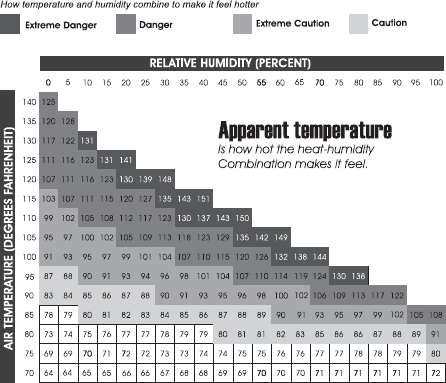
HT30-EU-EN V3.4 5/13
6
APPENDIX
The following is reprinted with permission of the National Oceanic and Atmospheric Administration.
A National Problem
Heat kills by taxing the human body beyond its abilities. In a normal year, about 175 Americans succumb to the
demands of summer heat. Among the large continental family of natural hazards, only the cold of winter -- not
lightning, hurricanes, tornadoes, floods, or earthquakes -- takes a greater toll. In the 40-year period from 1936
through 1975, nearly 20,000 people were killed in the United States by the effects of heat and solar radiation. In the
disastrous heat wave of 1980, more than 1,250 people died. And those are the direct causalities. No one can know
how many more deaths are advanced by heat wave weather -- how many diseased or aging hearts surrender, that
under better conditions would have continued functioning. North American summers are hot; most summers see heat
waves in one section or another of the United States. East of the Rockies, they tend to combine both high
temperatures and high humidity although some of the worst have been catastrophically dry.
Considering this tragic death toll, the National Weather Service has stepped up its efforts to alert more effectively the
general public and appropriate authorities to the hazards of heat waves -- those prolonged excessive heat/humidity
episodes. Based on the latest research findings, the NWS has devised the "Heat Index" (HI), (sometimes referred to
as the "apparent temperature"). The HI, given in degrees Fahrenheit, is an accurate measure of how hot it really feels
when the relative humidity (RH) is added to the actual air temperature. To find the Heat Index, look at the Heat Index
Chart. As an example, if the air temperature is 95°F (found on the left side of the table), and the relative humidity is
55% (found at the top of the table), the HI -- or how hot it really feels -- is 110°F. This is at the intersection of the 95°
row and the 55% column. Important: Since HI values were devised for shady, light wind conditions, exposure to full
sunshine can increase HI values by up to 15°F. Also, strong winds, particularly with very hot, dry air, can be
extremely hazardous. Note on the HI chart the shaded zone above 105°F. This corresponds to a level of HI that
may cause increasingly severe heat disorders with continued exposure and/or physical activity.
